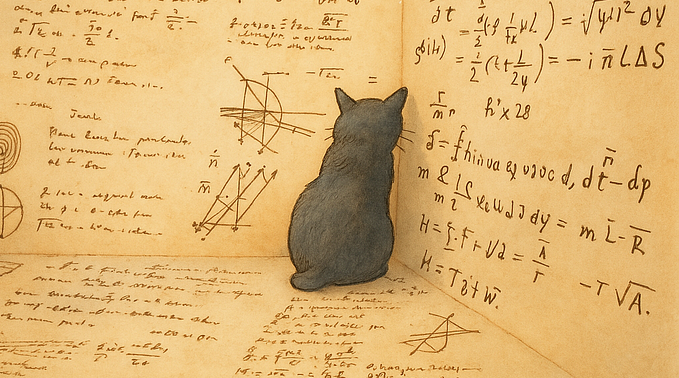Murray Gell-Mann : The Metaphysical Detective
A BEYOND BORDERS column by David Krakauer, President of the Santa Fe Institute

How to describe someone for whom a narrow list of his passions would include the life of birds, the collapse of ancient societies, the common roots of world languages, pre-Columbian pottery, the symmetries of space and time, and New Yorker cartoons?
In a profile of the editor of the New Yorker cartoon section, Emma Allen, Andrew Goldstein wrote, “It’s an article of faith in literary circles that the proper way to read the New Yorker is to start with the cartoons and then place the magazine atop a neat pile of older issues and wait for nuclear winter to free up time to read the rest.”
It struck me that this is exactly the kind of satirical observation that Murray would have relished. And Emma Allen says: “I actually have an aversion to any idea of the rules of funny, because if I’ve learned any- thing over the past five and a half years, it’s that the things that are the funniest defy the rules.” She goes on to describe her latest favorite cartoon: “Recently I got a submission that I loved of a croissant lying in the desert, with the caption, ‘The driest croissant in the world.’” I am not entirely sure why, but I am confident Murray would have loved that cartoon.
It seems to me that Murray achieved that point Cervantes did with Don Quixote, namely, finding a means of subverting reality in order to uncover its ubiquitous and hidden rules. And this is a subterranean tunnel to founding SFI — not aimed at recreation or endorsement of the establishment, not a recapitulation of a reputation-obsessed academy, but a spirit vehemently opposed to the cowardice of the status quo that militates against human discovery and well-being. Murray, with all of his merit badges, medals, accolades, and prizes, did what Quixote did in later life — he went in pursuit of dragons. And he accomplished what Quixote could not — he found them.
One of the books that Murray and I discussed was Gregory Bateson’s Naven, published in 1936. Bateson himself was one of the dying breed of polymaths who was drawn to a precursor of complexity — cybernetics — as a framework that might integrate — and in some way make sense of— the great diversity of his interests.
Bateson is best known for his book Steps Toward an Ecology of Mind, published later in 1972. Naven was written while Bateson lived in New Guinea with Margaret Mead, studying with the Iatmul people of the middle Sepik River. “Naven” is the name of a ritual practiced by the Iatmul; it is performed to congratulate members of the tribe on the completion of heroic deeds, where homicide ranks highest followed by genderless sexual experimentation. From the outside Naven looks impossibly opaque and baroque — with its apparent jumble of elements drawn from nature, society, mythology, development, and warfare.
Over the course of the book, Bateson explores a detailed exposition of the Iatmul approach to each of these particular elements. By the end, without Bateson explicitly explaining it to you, you have come to understand the Naven ceremony — and more surprisingly — gained the key to Iatmul cultural life.
Murray told me on several occasions that this approach of Bateson’s — to investigate the whole rich, perplexing phenomenology, and then care- fully delineate its elements — reveals the essence of understanding. An approach that you will be familiar with from his physics. I think that SFI was for Murray in part the application of the insights of the Iatmul Naven ceremony: an effort to make sense of the labyrinthine complexities of the adaptive world through an exploration of sufficient diversity and richness to make sense of it. And to do so with the all the power of mathematics and computation that are the legacy of our own post-enlightenment scholarly ceremonies.
I was recently re-editing with the SFI Press staff David Pines’ proceedings of the founding meeting of SFI and was writing a new introduction with Geoffrey West. We included the transcripts of all the founding discussions. These were dominated by Murray — in a very constructive way. One of the things he says is: “You could say that it’s a problem of personality types, that there are people who like cold logic, reason, analysis, and careful structuring of problems, especially in their work. There are other people who like syntheses, qualitative considerations, general remarks, natural history, and description. Finally, there are a few people who try to combine both. Some people call these Apollonian, Dionysian, and Odyssean types. If one can find just a few people who can combine these various characteristics, it would make an enormous difference.”
Most of you know that Murray was drawn to what one might call the metaphysical detective story — those of Conan Doyle, GK Chesterton, Edgar Allan Poe, and Jorge Luis Borges. And in the way that Borges is the keeper of the gates of the sensibility of our science — I think that the story “Funes the Memorius” is a melancholy reminder of the extraordinary abilities of MGM.
In Funes, Borges writes, “In the seventeenth century Locke postulated and condemned an impossible language in which each individual thing — every stone, every bird, every branch — would have its own name. Funes once contemplated a similar language, but discarded the idea as too general, too ambiguous. The truth was, Funes remembered not only every leaf of every tree in every patch of forest, but every time he had perceived or imagined that leaf . . . . He saw that by the time he died he would still not have finished classifying all the memories of his childhood.
We shall miss Murray, the original Metaphysical Detective covering the precincts of complexity. Verae vollaut ea nientiandam ides sent volentotat.
From the Summer 2019 Edition of the SFI Parallax. Read here.









